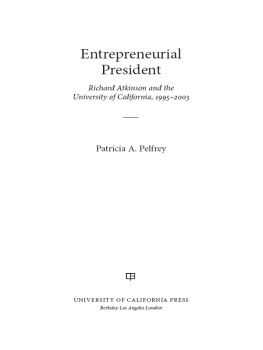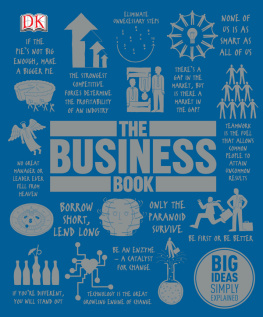Entrepreneurial President
The publisher gratefully acknowledges the generous support of the General Endowment Fund of the University of California Press Foundation.
Entrepreneurial
President
Richard Atkinson and the
University of California, 19952003
Patricia A. Pelfrey

UNIVERSITY OF CALIFORNIA PRESS
Berkeley Los Angeles London
University of California Press, one of the most distinguished university presses in the United States, enriches lives around the world by advancing scholarship in the humanities, social sciences, and natural sciences. Its activities are supported by the UC Press Foundation and by philanthropic contributions from individuals and institutions. For more information, visit www.ucpress.edu.
University of California Press
Berkeley and Los Angeles, California
University of California Press, Ltd.
London, England
2012 by The Regents of the University of California
Library of Congress Cataloging-in-Publication Data
Pelfrey, Patricia A.
Entrepreneurial President : Richard Atkinson and the University of
California, 19952003 / Patricia A. Pelfrey.
p. cm.
ISBN 978-0-520-27080-0 (hardback)
1. Atkinson, Richard C. 2. University of California (System)PresidentBiography. 3. University of California (System)History. 4. University of California (System)Management. 5. Nuclear energyResearchLaboratoriesManagement. I. Title.
LD755.A87P45 2012
378.0092dc23
[B]
2011042080
Manufactured in the United States of America
20 19 18 17 16 15 14 13 12
10 9 8 7 6 5 4 3 2 1
In keeping with a commitment to support environmentally responsible and sustainable printing practices, UC Press has printed this book on Rolland Enviro100, a 100% post-consumer fiber paper that is FSC certified, deinked, processed chlorine-free, and manufactured with renewable biogas energy. It is acid-free and EcoLogo certified.
CONTENTS
FOREWORD
I was delighted to be asked by the author to prepare a foreword for her booka story focused on milestone events in the history of the University of California coinciding with the tenure of its seventeenth president, Richard C. Atkinson. While this period represents only 6 percent of the Universitys history, its temporal place in the history of our nation and the state of California gives it particular significance. Entrepreneurial President is a story about a university in which I have spent virtually my entire adult lifeas student, faculty member, and academic administratorand about a man, colleague, and friend for whom I have unmatched respect and admiration. I entered Berkeley as a seventeen-year-old freshman in 1942. Nearly seven decades later, now a triple emeritus at Berkeley, the opportunity to read Patricia Pelfreys book brought a special pleasure. I have had the opportunity to know and in a variety of different capacities to work or be associated with the last nine presidents of the University. It is from this perspective that I write this foreword.
While there is a major focus on the Atkinson presidencythe man himself, the people inside and outside the University with whom he was engaged, and the trials and tribulations he experienced and largely effectively dispatchedthere is much more to be found in this book. Pelfrey discusses three major issuesthe Universitys transition to the postaffirmative action age; the expansion of its research enterprise; the controversy over its management of the Los Alamos and Liver-more National Laboratoriesalways placing them in the larger historical context in which the University evolved. And, for the University of California, there is no shortage of complexity in this context.
Within the University one must number Regents, faculty, staff, students, and academic administrators as well as alumni. Outside the University are elected officials at all levels, business leaders, and members of the general public. Each of these groups has a tendency to view the president and his actions from a less than broad perspective. Pelfreys thirty-two years in the Office of the Presidentduring which time she was challenged to work closely with five presidents of widely differing personalities and stylesafford both a level and a breadth of understanding of everyday life in the Office of the President (UCOP) that few if any possess.
The story begins with what might be called the initial conditions that defined a significant part of the evolution of policy and practice in the University through Atkinsons tenure: the Regents adoption of Resolutions SP-1 and SP-2, ending the use of gender, racial, and ethnic preferences in admissions and employment. The oft-quoted remarks of President Daniel Coit Gilman at his inauguration define the issue that consumed the Regents for many months and remain equally challenging today: It is the University of this State. It must be adapted to this people, to their public and private schools, to their peculiar geographic position, to the requirements of their new society and their undeveloped resources. It is of the people and for the people. Striving to answer the question Who are the people? is a theme found throughout this book.
In January 1995 President Jack Peltason announced his intention to retire the following October. This set off a search process by the Regents marked by the withdrawal of the first choice amid a flurry of bad publicity and a contentious sequel of events surrounding adoption of the two antiaffirmative action resolutions. A divided Board of Regents and an unhappy faculty and student body greeted Richard Atkinson when he assumed the presidency on October 1, 1995. As a very young man Dick Atkinson was shaped by the liberal education he acquired at the University of Chicago in the styles of Robert Maynard Hutchins and Mortimer Adler. His graduate work in experimental psychology, strengthened by his passion for and knowledge of mathematics and statistics, led him to Stanford, where he met and was impressed by the dean of engineering, Fred Terman. Two subsequent appointmentsas director of the National Science Foundation and as chancellor at UC San Diegoplayed an important role in defining the character of Atkinsons presidential style and his approach to dealing with the three issues that are the focus of this book.
Atkinson was a man of action who expected the same from his staff. Having known and worked closely with him over a period of three decades, I would add that the intellect of this man of action was off-scale among colleagues in the academic world. In conversations I frequently found him completing my sentences and urging me to go on with my business. The knowledge he acquired in fifteen years as chancellor at San Diego, coupled with his record of scholarship and his knowledge of the byzantine concept of shared governance in the University, assured his position with the faculty and his fellow chancellors.
The passage of resolutions SP-1 and SP-2 during the final months in office of Atkinsons predecessor placed the new president in command of a ship whose crew showed signs of mutiny and whose owners were divided, riding in storm-tossed waters of politics. Pelfrey carefully leads the reader through this perilous journey with remarkable understanding and attention to detail. As a ships officer during this voyage, I can attest to the events and their significance. Although the change in admissions policy dictated by the passage of SP-1 was a matter of record, its effective date was unrealistic in terms of the Universitys admissions calendar. The presidents decision, through a series of events, some accidental and some intentional, came close to ending his tenure at an early date. The author carefully documents the resulting tension over the issue of presidential authority with respect to the Board of Regents. This is done in the context of the additional dispute that placed many faculty members at odds with the board over the matter of shared governance, namely, the Academic Senates delegated authority to recommend the conditions for admission. That the University survived this extremely destructive period in its history is a testament to the quality and commitment to its mission of the people who serve it.
Next page







